
The Dutch goth scene: From übergoths to 'light' goths
A night in the spring of 2007. On the stairs in front of the Waterfront event venue in Rotterdam, a mix of black and neon colours are accompanied by young people wearing latex clothes and plastic tubes in their hair. For outsiders of the (cyber) goth subculture, the scene must have looked strange at the very least, but for me it felt like home.
Noises that could have come straight out of a factory mixed with dark hardcore sounds escaped the building. People appeared to recognize each other, not because they knew each other personally, but by virtue of displaying a certain arrogant attitude. All of it was part of an unspoken code of behaviour that everybody seemed to understand. The goths present at the party were exceptionally well-dressed. Every detail on their body and in their behaviour had a mysterious feel that matched the dark and futuristic décor of the dancefloor. The people accompanying me to the party had this same proud and elegant attitude, but behind their almost un-human appearance, they were like every other ‘normal’ person if you talked to them. Their buckled, extremely tall platform boots, neon-coloured hair, cat eye contacts and almost arrogant attitude were like a buffer between them and the rest of the world. Still, when you danced with them on the dancefloor among other insiders, you saw they were cheery and friendly.
At the end of the 2000's, halfway to the tens of this century, goth parties like Cyberia, Summer Darkness and Storm (described above), closed their doors. Vice magazine declared the Dutch goth scene dead when Cyberia in Utrecht, the last of the goth parties, stopped.
This article is an attempt to find out what has become of the Dutch goth scene now, more than a decade after it seemingly stopped being the flourishing subculture it was in the 2000's. In what follows, I will examine the Dutch goth scene as it stood as a subculture more than 10 years ago, and its recent transformation into a commodified niche.
The Dutch goth scene as a subculture
A good way to understand the differences between the Dutch goth scene then and now is to analytically compare Dutch gothic message boards in the 2000's and contemporary goth communities on social media. For the descriptions of the gothic subculture at the start of this century and the description of the contemporary notion of gothic subculture, I adopt digital etnography as an approach to study digital culture. 'Digital ethnography as an approach is built on ethnography as used by anthropologists who research the living reality of people' (Varis, 2014, p. 3). The data has been collected from various online subcultural communities active in 2003–2007 as well as contemporary communities on social media (which did not yet fully exist in those years).
The subculture had a certain core set of rules that one had to obey to be seen as an authentic member.
Becker (1963) describes a deviant group as a group that shares common understandings and, thus, a culture. The gothic subculture can be considered a deviant group. 'Although their activities are formally within the law, their culture and way of life are unconventional, causing them to be outsiders by more conventional members of society', as Becker (1963, p. 79) states. The gothic subculture is described by insiders as ‘a scene or subculture with a dark and creative sphere’ in which they feel at home (Jasper, 2004).
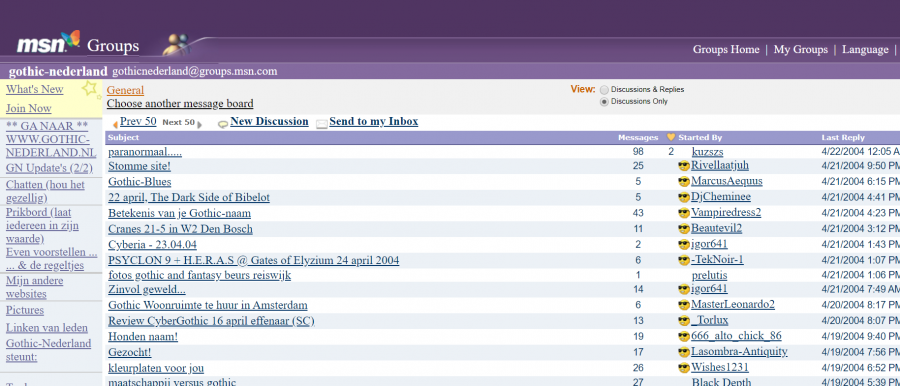
Figure 1 A Dutch message board which shows some of the main topics that were discussed within the gothic subculture. Gothic was a distinct way of life that covered multiple micro - hegemonies of someones life.
The Dutch goth scene was a subculture that spread over multiple micro-hegemonies in a member's life. The picture above suggests that someone was not considered goth just for putting on a black dress or latex pants. People had names that were ‘gothic’, their nihilistic and cynical attitude was gothic, and even gothic living spaces were apparently for rent in Amsterdam in 2003.
Agnes Jasper, a gothic insider and anthropologist from the University of Amsterdam, argues that insiders have to inform themselves constantly on what their subculture is actually about. 'They have to be in constant dialogue with the subculture' (Jasper, 2004, p. 94). The goth subculture had a certain core set of rules that one had to obey to be an authentic member. Becker argues that deviant groups are generally long-lasting and stable, like the dance music subculture. The same counts for the gothic subculture, which has been around from the late seventies of the twentieth century. 'Deviant groups develop a distinctive way of life and to understand the behaviour of members of such groups, it is necessary to understand their way of life' (Becker, 1963, p. 79).
Keeping outsiders away from the ‘holy goth essence’
In order to understand the Dutch goth scene, one can analyze their behaviour in online community spaces. People's behavior on these message boards truly represents them; they have a specific function and uptake in mind when posting messages, for example (Varis, 2015). A certain subcultural frame is active that explains why members of a community behave in a certain way.
Insiders of the Dutch goth scene of the 2000's, 'emphasised not to be goth, but to identify with what they describe as gothic, which they then claim not to be gothic' (Jasper, 2004, p. 90). The scene had an authenticity discourse that Jasper called the ‘negative dialectic’. It is a paradox, a set of strategies that goths applied to protect their subculture from classification by outsiders. This can be compared to the way Becker's (1963) jazz musicians warded off the ‘squares’ and the way hipsters nowadays reject the label 'hipster' as a category of self-identification (Varis & Maly, 2016). In what follows, I will be referring to the members of the Dutch goth scene as ‘insiders’.
The fact that great effort was put into protecting the subculture, points to the nature of the goth scene as a deviant culture. The first strategy used by insiders in the Dutch goth scene was their tendency to make fun of themselves and the cliché’s of their subculture. 'Laughing about subcultural stereotypes means insiders distancing themselves from their stereotypical goth identity. Both outsiders and insiders themselves are being made fun of; a double irony' (Jasper, 2004 p.98). Below are some examples of the way Dutch goth insiders used humour to keep outsiders away.
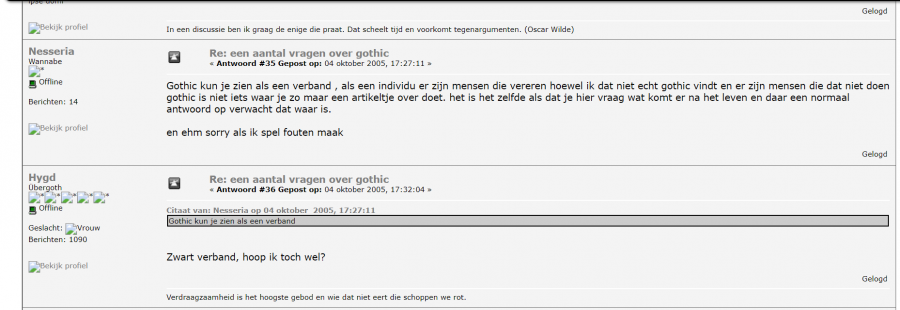
Figure 2 Humour by which the member of the community mocks their own subculture. Self - irony used to be very common in the Dutch goth scene. ‘Verband’ means both ‘connection’ as ‘bandage’ in Dutch. ‘Nesseria’ meant ‘conection’ whereas ‘Hygd’ joked about
Another example of this 'double irony' used to ward off outsiders emerges around the topic of people with a dark skin tone being goth. ‘It is such a convenience that black people don’t have to put so much effort in appearing in black fully. If I was a black person, I would definitely want to be part of the ‘goth circle’, an insider remarks sarcastically. Also the term ‘Übergoth’ (Jasper, 2004, p. 98, p. 113), literally meaning ‘highest of goths’ or 'supreme goth', was a joke through which the insiders ridiculed themselves. The term can easily be mistaken as arrogant, but on the subcultural message board examined it simply means having posted a certain amount of posts. Übergoths are 'fuller members' or 'masters' in Becker's (1963) sense, as they are recognized as having gone through the stages of the 'Dutch goth career'.
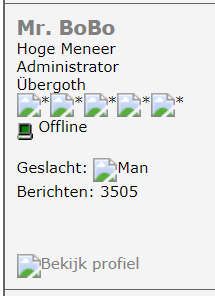
Figure 3 'high sir' and 'ubergoth' ,but don't take these titles too serious.
Secondly, insiders intentionally kept the definition of the gothic subculture vague. The notion of 'gothic' was guarded as something ungraspable that one simply is or is not. 'Gothic is a holy that must remain hidden, untouched and unnamed.' (Jasper, 2004, p. 4). In January 2006, a high school student unsuspectingly made the mistake to ask members of one of the main Dutch gothic message boards what ‘gothic’ is and what its ‘characteristics’ are. The questions were received with irony and hostility:
Wolfje 88 (student writing a paper about the gothic subculture): ‘I did not come here to judge people. With all due respect, I only asked a question.’
Bat (popular member of the community): ‘Gothic is a concept that is too broad to define. You’d better make the question more specific. Besides, the questions are linguistically weak and why don’t you just use Google?’
Sorcha_79 (other member): ‘Good luck with those questions of yours. I don’t feel the need to answer them, because it is way too popular lately to do research on the gothic subculture. Most goths just want to be left alone, but I guess you have already figured that out yourself…'
These responses point to the fear of insiders that their subculture might be ‘grasped’ by outsiders. This is because, as soon as criteria for sub-cultural identity are conceptualised, they can be copied by outsiders, which insiders want to avoid at all costs (Jasper, 2004).
It is crucial that not everyone should ‘know the rules’, otherwise the subculture would cease to exist.
As Becker (1963) has argued, knowledge of the rules of a certain social group, are a prerequisite for being an insider. Therefore, it is crucial that not everyone should ‘know the rules’, otherwise the subculture would cease to exist. What is also important to mention here, is the fact that gothic was seen as something one either was or was not. It could not be bought or learned (Jasper, 2004).
The ‘holy goth essence’ was quite similar to the ‘musical gift’ Jazz musicians in Becker's (1963) research emphasised having. ‘The gift is something which cannot be acquired through education; the outsider can thus never become a member of the group' (Becker, 1963 p. 86). The analysis of pre-contemporary goth communities, shows that the Dutch goth scene went very far in protecting their subculture. Often outsiders of the Dutch goth scene on old message boards were approached with hostility:
Bat: ‘As for me, you can enjoy cholera with this little project of yours.’
Hydrochlorine (another member): ‘I think you can better leave decent conversations to Bat than to this little wolf cub with rabies.’
Another attempt was made to define the gothic subculture on another topic. An anonymous user asked questions that came too close to the ‘holy essence’ of the gothic subculture and was told to ‘get lost with her retarded questions’.
A third strategy used to keep outsiders away and to prevent outsiders from defining the subculture, was labelling others as ‘not goth’. This is part of the ‘negative dialectic’ described earlier. Insiders indirectly identify themselves as goth when saying someone else isn’t goth, but being called goths by outsiders was deemed the worst (Jasper, 2004).
This gives insiders control over deciding what is and what is not 'goth'. Many (sometimes degenerative) synonyms existed for outsiders; for example, an outsider could be called a ‘wannabe’, a term for people trying too hard to fit into the goth scene but totally missing the subcultural rules. Another popular term was ‘WT gothje’, referring to fans of the Dutch pop/rock band Within Temptation that mistook it for goth music. This is comparable to the way Becker’s Jazz musicians called people that were not Jazz musicians ‘squares’; i.e., 'people that did not possess the ‘mysterious artistic gift setting musicians apart from all other people’' (Becker, 1963 p. 85).
Not displaying enough 'indexes' of goth identity made someone an outsider, but displaying too many made someone inauthentic.
Further, in order to protect the subculture, goths also denied being goths and emphasised their status as ‘ordinary people’ like everybody else (Jasper, 2004). By claiming to be ‘ordinairy people instead of goths’, insiders tried to make outsiders less curious about their subculture suggesting that: ‘Look, people, there’s nothing to see (or define) here’.
‘What’s so deviant about gothic then? They’re just normal people like every other of the millions walking around here in The Netherlands. They just like black clothes and alternative music. Oh look, I just described the entire goth culture in one sentence’, user Unter_Null remarks ironically.
A last remark to be made about the Dutch goth scene, is that it ascribed to the notion of ‘enoughness’ (Blommaert & Varis, 2015), which was embedded in its subcultural rules. Not displaying enough 'indexes' of goth identity made someone an outsider, but displaying too many made someone inauthentic. Wearing jeans would not grant you entrance to a goth party, but dressing up with a white-painted face and a long velvet cloak would also not suffice.
The curtain falls: the Dutch goth scene dies out
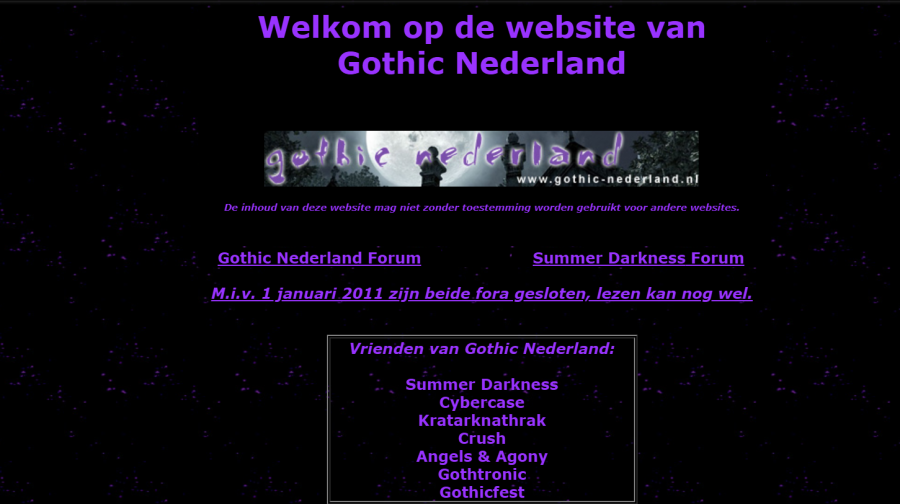
Figure 4 Starting January first 2011, both the Summer Darkness and Gothic Nederland message board will be closed.
Talking about Dutch goth parties, rules, jokes, strategies and places to be in the past tense might make one wonder what has happened to all these things. ‘Cyberia [a popular goth party in Utrecht] quits’, Sven Schlijper writes in a Vice article in 2015. 'It was the place where new acts were first seen in The Netherlands and where DJ-careers started. [...] As ‘one of the last Mohicans’, Cyberia was still standing, but not anymore.’
Not only do goths in The Netherlands appear to have vanished, but subcultures are dying all around, Schlijper argues, blaming the internet and what he calls ‘transformative identity’ for it. ‘When Cyberia started twenty years ago, it meant something to be alto, skinhead, punker or skater. Now these categories have fallen away.’ I personally remember hearing about the end of the last goth party and thinking, so this is it then? And it was. ‘The parties remained, but have gotten another purpose’, Schlijper continues. ‘The attention moved from the music to the way you looked. Goths of today want more of the same, or else nothing at all. Parties become a dress up party in cybergoth uniform. Under the pressure of the internet, everything becomes liquid. Transformative identity comes down to this: one time you are this, the other time something else.’
What Schlijper means by this is that the subculture has become fragmented in micro-hegemonies. While being a member of the Dutch goth scene before meant generally having a distinct way of life, it now means nothing more than wearing a leather jacket to a New Wave revival party for a day. Robust hegemonies characterizing modernity have been traded for a blending within one individual life project consisting of several micro-hegemonies valid in specific segments of life. Micro-hegemonies provide ‘the most logical solution’ and, for each part of their life, a person can shift and deploy an entirely different speaking register, genre and viewpoints (Blommaert & Varis, 2015 p. 4). This explains why we don’t see many subcultural expressions in the streets anymore. The micro-hegemonies valid at a goth party are no longer of any value in other segments of life.
'Light' communities are groups that exist in light of a shared event or act and cease to exist afterwards.
Goths have become ‘light' communities: communities that are not tied together by the vast amount of backgrounds, shared space and cultural assumptions as to what makes social life and structure (Blommaert & Varis, 2015, p. 3); instead, 'light' communities are groups that exist in light of a shared event or act and cease to exist afterwards. 'The diversity that characterized the group, even while displaying tremendous uniformity during the event [for example, a goth concert] re-emerges as soon as the moment of focusing is over' (Blommaert & Varis, 2015, p. 55).

Figure 5: Pauley Perrette as Abby Sciuto. This personage of TV series NCIS was not just 'goth for a day'. A rare occurrence in contemporary society.
Looking at the issue on a wider scale, respected English journalistic publications also report on the disappearance of subcultures visible on the street. The reason is the internet, according to both Vice and The Guardian. ‘The internet doesn't spawn mass movements, bonded together by a shared taste in music, fashion and ownership of subcultural capital: it spawns brief, microcosmic ones,’ Alexis Petridis tells readers of The Guardian.
Next to the internet, the commodification of 'goth' is likely to have contributed to the dissapearance of goths in the streets. Dick Hebdige (1979) argues in his book Subculture: The Meaning of Style, that the moment dominant society begins to recognize a subculture, the resistance power of the subculture begins to die out. The commodification of gothic indexes shows that the gothic subculture has been noticed in 'mainstream' society.
Another phenomenon that contributes to the loss of subcultural essence, is the recognisability of ‘active semiotic substance’. 'In getting the right amount of subcultural indexes, a very small semiotic dose is enough for a certain identity discourse to be activated' (Blommaert & Varis, 2015 p. 9). This means that wearing a black satin corset to a goth party is already enough. But what about the attitude, habits, jokes and special styles the Dutch goth scene used to have? The fact that one or a few stereotypical emblematic resources nowadays suffice in order to be recognised as a member of an identity category leads to what Schlijper calls ‘gothic light’: a pale and colorless kind of gothic that is nevertheless popular. 'Identities are not randomly being absorbed but instead become an accented package. We enter and leave these accents and niches often in rapid sequence. In doing this we change style and behaviour each time and deploying the resources we have collected for performing each of these identities' (Blommaert & Varis, 2015 p.14).
Contemporary notions of gothic in the Netherlands
The contemporary Dutch goth scene can no longer be called a ‘scene’, or subculture because gothic has become a micro hegemony expressed in details for a short moment. The social factors that add up to a subculture have disappeared. But if gothic is no longer to be called a subculture (at least not in the Netherlands), what is it then? Gothic is a ‘dark and commodified template’ that one can buy and experience. This must have been a nightmare for pre-contemporary goth culture insiders as parts of the goth style that were once uniquely for insiders have now become commodified in niche stores. The 'holy essence' of goth culture is now fragmented and reduced into details. 'Feelings of ‘being yourself’ are now based on miniscule deviations from standard scripts' (Blommaert & Varis, 2015, p16). And ‘standard scripts’ are by definition not what would be called gothic back in the day because the gothic subculture was all about being deviant.
Knowing the rules of the subculture is no longer a requirement; spending money suffices to become part of the VIP group.
'The pattern of culture as an accent and inflection of standard codes, is part of consumer culture' (Blommaert & Varis, 2015, p. 16). On contemporary social media sites about gothic, commodification and niche interest have been taken to the extreme. Below is a ‘VIP group’ which one can join for ‘only 4.99 dollars a month’.
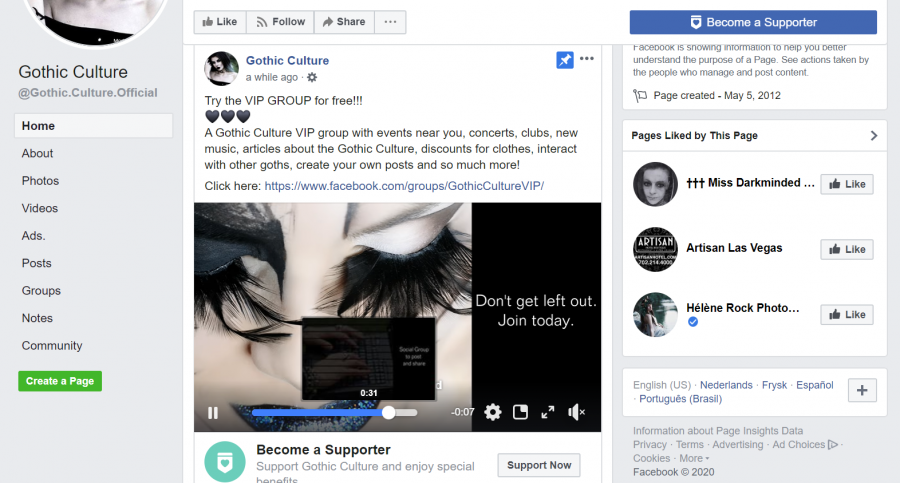
Figure 6 a VIP goth group on Facebook. One is left out from the 'goth culture' when not being part of this group. Also, supporting Gothic Culture will give you access to ‘special benefits’
It appears as if one can ‘buy into’ a global goth scene. The main site advertising the VIP group has over half a million followers. Although it is an example from American/global notions of gothic culture, it shows how something that once started as an underground subculture is now a commodity. Knowing the rules of the subculture is no longer a requirement; spending money suffices to become part of the VIP group.
Saying goth parties are entirely gone in the Netherlands would be greatly inaccurate. There is an abundance of goth parties both in the Netherlands and in Flanders. They are accessible to all who are interested in the music being played there. The people going to these parties can be seen as constituting 'light' communities. They converge or coagulate around a shared focus – an object, a shared interest (gothic music) or an event (the goth party). 'This focusing is occasioned in the sense that it is triggered by a specific prompt, bound in time and space' (Blommaert & Varis, 2015, p. 54). Going to a contemporary goth party or concert is almost like watching a good documentary about the gothic subculture. It is nice to look at, but can never simulate the feeling of truly being there. Something seems missing. A sphere, a sense of home, something that is unnameable and ungraspable.
Goths and New Wave revival parties
New Wave revival parties are still popping up and goth bands are still performing in the Netherlands frequently. What has disappeared, however, is the common norms, rules and specific attitudes that characterized the Dutch goth scene. If goth isn’t dead, then the Dutch goth attitude is. Newbies in the Dutch goth scene were not received with open arms in the 2000’s, but were instead approached by ‘übergoths’ with skepticism and discontent. If someone proved themselves by showing intelligence, listening to the right music and having the exact right amount of indexes, it might have been possible for that someone to become an insider. Nowadays we see niche groups about gothic model-photography and specific music announcers. Gothic is no longer a full lifestyle that encompasses every aspect of life, but a collection of dark details and of interests that come and go. Goth communities on social media no longer enforce rules to divide insiders from outsiders. One only has to pay an amount of money in the case of VIP-groups (which showcase the commodification of goth culture) or subscribe to a niche Facebook group. The underground subculture has become a translocal, niched commodity.
At goth parties today, the pressure is off. Dress codes are no longer mentioned and rules no longer apply. The music is still popular and goth clothes are still (widely) available. Still, goth in the sense of a subculture in which exclusion-focused rules are very actively enforced, is dead. Since such rules are no longer enforced, goths are no longer recognizable as a distinct subculture. New Wave and Industrial lovers dress for the occasion when a goth party is on and lead their non-goth lives after the event, making gothic a mere ‘light' community.
References
Becker, H. (1963). Outsiders: Studies in the Sociology of Deviance. New York: The Free Press.
Varis, P. (2014). Digital Ethnography. Tilburg Papers in Culture Studies 104, Tilburg University.
Hebdige, D. (1979). Subculture: The Meaning of Style. London; New York: Routledge.